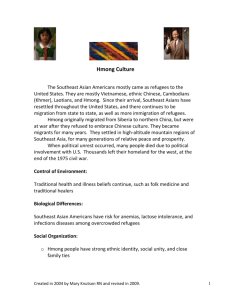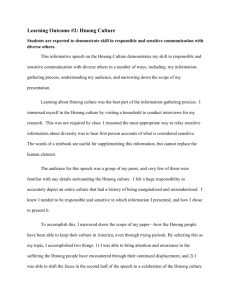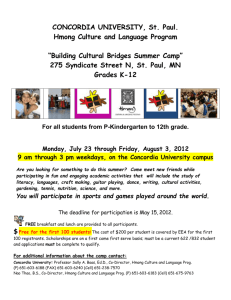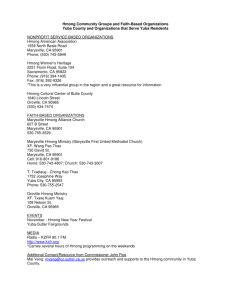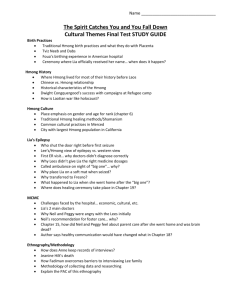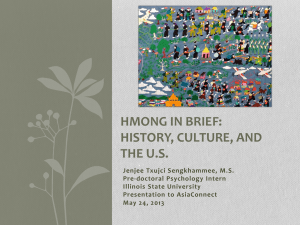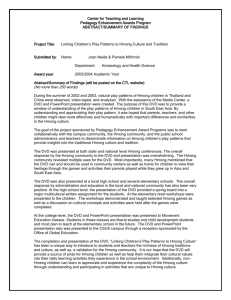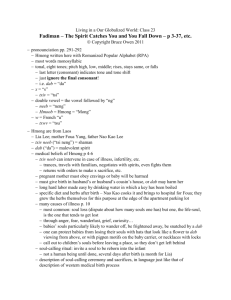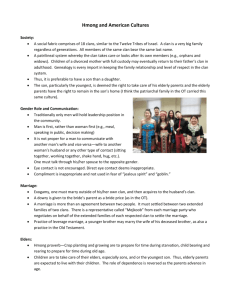Students introduce themselves--Hmong-style!
advertisement
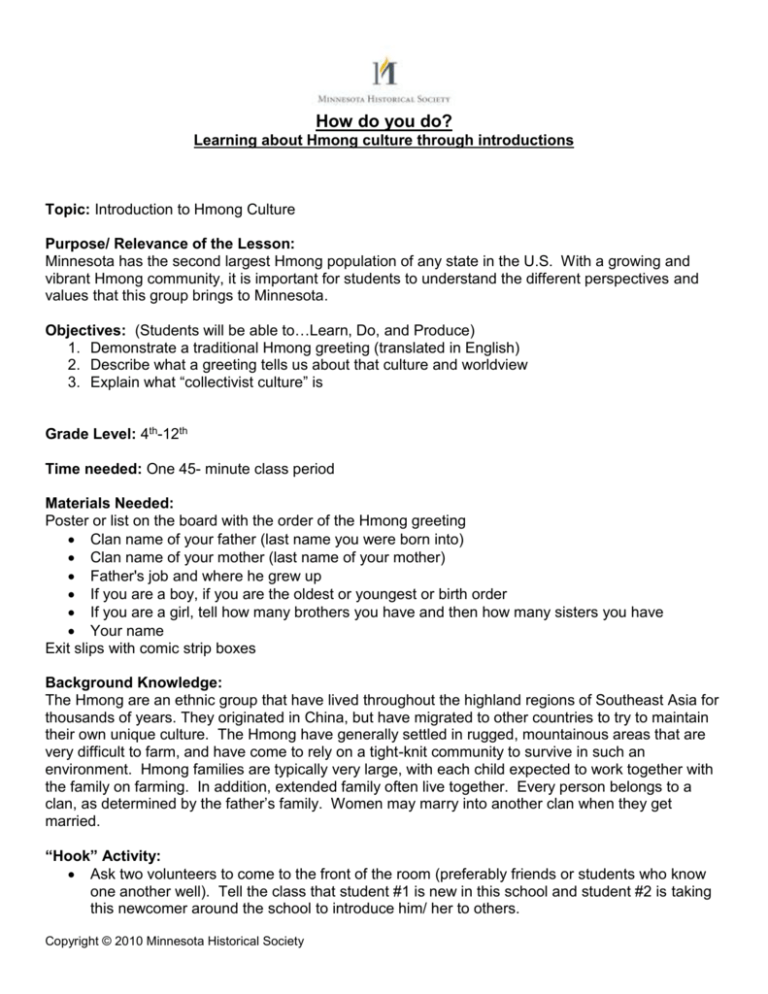
How do you do? Learning about Hmong culture through introductions Topic: Introduction to Hmong Culture Purpose/ Relevance of the Lesson: Minnesota has the second largest Hmong population of any state in the U.S. With a growing and vibrant Hmong community, it is important for students to understand the different perspectives and values that this group brings to Minnesota. Objectives: (Students will be able to…Learn, Do, and Produce) 1. Demonstrate a traditional Hmong greeting (translated in English) 2. Describe what a greeting tells us about that culture and worldview 3. Explain what “collectivist culture” is Grade Level: 4th-12th Time needed: One 45- minute class period Materials Needed: Poster or list on the board with the order of the Hmong greeting Clan name of your father (last name you were born into) Clan name of your mother (last name of your mother) Father's job and where he grew up If you are a boy, if you are the oldest or youngest or birth order If you are a girl, tell how many brothers you have and then how many sisters you have Your name Exit slips with comic strip boxes Background Knowledge: The Hmong are an ethnic group that have lived throughout the highland regions of Southeast Asia for thousands of years. They originated in China, but have migrated to other countries to try to maintain their own unique culture. The Hmong have generally settled in rugged, mountainous areas that are very difficult to farm, and have come to rely on a tight-knit community to survive in such an environment. Hmong families are typically very large, with each child expected to work together with the family on farming. In addition, extended family often live together. Every person belongs to a clan, as determined by the father’s family. Women may marry into another clan when they get married. “Hook” Activity: Ask two volunteers to come to the front of the room (preferably friends or students who know one another well). Tell the class that student #1 is new in this school and student #2 is taking this newcomer around the school to introduce him/ her to others. Copyright © 2010 Minnesota Historical Society Ask Student #2 to do an introduction of Student #1. Now tell the class that you are attending a camp for a week. The camp leader has asked to go around in a circle and have each person say a little bit about yourself to the other students at the camp. Ask Student #1 and Student #2 to do an introduction to the group, making at least 5-6 statements about him/ herself. Have these two students return to their seats. (If necessary, you may also do a self-introduction to demonstrate what adults might include in a self-introduction) Draw a chart on the board that looks like this: Introducing someone else Self-introduction #1 Self-introduction #1 Ask the class to help fill in the chart. What did Student #2 say about student #1 when introducing him/ her? (Try to guide them to list the correct order of what was said in the introduction.) Next, ask students what person #1 said about himself or herself when doing a self-introduction. Finally ask what person #2 said about himself or herself when doing a selfintroduction. Lesson Procedure: 1. Have the class look at the lists in the chart, and try to categorize what kind of information we share about ourselves when we do an introduction in the U.S. Ask what this might say about our values in the U.S —specifically what we value in people. 2. Define “individualism” on the board. 3. Discuss some of the guiding principles of American society: independence, competition, determination, hard work, and self-promotion. 4. Ask how these values are apparent in the lists of things covered in the introductions. 5. Next hand out a short reading on Hmong culture (this can be adapted from the Becoming Minnesotan website) that describes life in a collectivist culture. 6. Instruct students that they will now do an introduction following the Hmong model. Point to your poster or list on the board with the correct order of the introduction. Clan name of your father (last name you were born into) Clan name of your mother (last name of your mother) Father's job and where he grew up If you are a boy, if you are the oldest or youngest or birth order If you are a girl, tell how many brothers you have and then how many sisters you have Your name 7. Assign students to pairs and ask each student to take turns introducing himself or herself to the other person. Copyright © 2010 Minnesota Historical Society 8. Have students return to their seats. Ask students how that felt to talk about those parts of his or her life in an initial introduction. 9. Define “collectivist culture” on the board. Discuss some of the guiding principles of a collectivist culture: interdependence, distribution of work, teamwork, and selflessness. Assessment: As an “exit slip” ask students to complete a short comic book/ graphic novel/ cartoon showing the six different things included in a Hmong introduction, and respond to the following three questions: 1. How was this introduction different than others that you have had? 2. What does a greeting tell us about a culture? 3. What did you learn about the Hmong collectivist culture? Example: Hello, My father is a Carlton. Ideas for Differentiating Instruction: Ask the student to write an introduction instead of practicing a verbal Hmong introduction with a partner. Ask a student to observe another pair practicing the Hmong introduction. Do not have student participate in the practice introductions, but give him/ her extra time to work on the comic strip showing the steps of the Hmong introduction. You (teacher) show short video clips showing introductions from other parts of the world, and have student write down what they contain. Have students work in pairs on their comic strips, with one drawing the pictures and the other writing the text. Additional Resources: “Becoming Minnesotan: Stories of Recent Immigrants and Refugees” website: https://www.mnhs.org/immigrant Copyright © 2010 Minnesota Historical Society
